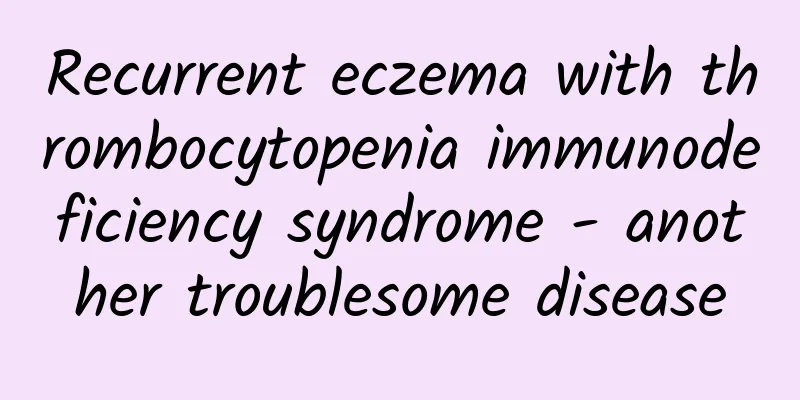Recurrent eczema with thrombocytopenia immunodeficiency syndrome - another troublesome disease

|
This is the 4192th article of Da Yi Xiao Hu Bleeding Disease When Xiaoyu (pseudonym) was two years old, he had irregular nosebleeds. He visited the local hospital many times but there was no obvious effect. His platelets were always maintained below 20×109/L. In 2014, he underwent genetic screening and was finally diagnosed with eczematous thrombocytopenia with immunodeficiency syndrome. In April 2016, Xiaoyu went to the Department of Hematology of the Capital Institute of Pediatrics for treatment due to high fever and nosebleeds caused by infection. After the nosebleed stopped and the condition stabilized, the attending physician, the director, told the parents that the only way to cure the disease was to do a hematopoietic stem cell transplant. Subsequently, the doctor collected blood samples from Xiaoyu and his parents for pre-transplant matching. The matching results showed that Xiaoyu's father and mother had 5 points each, which means "half-matched". On June 6, 2016, the doctor collected hematopoietic stem cells and peripheral blood from Xiaoyu's father and then transfused them back to Xiaoyu. The whole process went smoothly, and the chimerism reached 99%, indicating that the transplant was successful. Because Xiaoyu had received a lot of platelet transfusions before the transplant, antibodies appeared in his body. The director of the division decisively decided to do a plasma exchange. After the exchange, Xiaoyu's platelets rose to normal values. On July 19, Xiaoyu was discharged smoothly. At present, Xiaoyu's body is recovering, and the immunosuppressant used to resist rejection is slowly reduced, and the platelet count is maintained at around 200×109/L. What is recurrent eczema with thrombocytopenia immunodeficiency syndrome? Recurrent eczema with thrombocytopenia immunodeficiency syndrome, also known as Wiskott-Aldrich syndrome (WAS), is an X-linked recessive genetic disease with typical clinical manifestations of immunodeficiency, eczema and thrombocytopenia. Atypical cases may mainly present with thrombocytopenia without obvious immunodeficiency. In this case, it is necessary to differentiate from idiopathic thrombocytopenic purpura. The manifestations of the blood system are often more prominent, and bleeding tendency may occur after birth, including purpura, melena, hematuria, etc., with a significant decrease in platelets and a decrease in platelet volume. The incidence of neonatal WAS is (1-10)/1000000, and it mostly occurs in males. What are the symptoms of recurrent eczema with thrombocytopenia immunodeficiency syndrome? 1. This disease is more common in boys. 2. Bleeding tendency: It is the most important clinical feature of WAS. Patients have bleeding tendency since birth, which may manifest as ecchymosis, purpura, nosebleed, gingival bleeding, subconjunctival hemorrhage, hematemesis, hematuria, bloody stool, intracranial hemorrhage, etc. 3. Eczema: Another characteristic manifestation of WAS, it often appears a few months after birth. With age, eczema can become more severe and difficult to control. Eczema is characteristically distributed on the head, face, forearms and popliteal fossa, but can spread throughout the body as the disease progresses. Some eczema is accompanied by infection or bleeding. 4. Recurrent infections: Most patients will experience recurrent infections, especially pneumonia, meningitis, otitis media, upper respiratory tract infections, and skin infections. 5. Others: Hepatosplenomegaly is common. Some children have arthritis, kidney disease, autoimmune hemolytic anemia, etc. Older children are more likely to develop malignant diseases, especially lymphoreticular malignancies. 6. Atypical children do not have recurrent infections and eczema. How to treat recurrent eczema with thrombocytopenia immunodeficiency syndrome This disease requires an individualized comprehensive treatment plan based on its severity, course of disease, WAS gene mutation and WAS protein (WASp) expression. 1. General treatment Supportive care and antibiotic prophylaxis are necessary, such as the use of trimethoprim-sulfamethoxazole to prevent Pneumocystis carinii pneumonia. Intravenous immunoglobulin, platelet transfusion, and splenectomy may be given if necessary. Severe eczema can be treated with glucocorticoids. 2. Hematopoietic stem cell transplantation Hematopoietic stem cell transplantation is currently the most effective method for curing WAS. Children with WAS who do not express WASp should undergo hematopoietic stem cell transplantation as soon as possible after diagnosis. 3. Gene therapy Gene therapy avoids rejection after transplantation and does not require matching, which is conducive to timely treatment of WAS. However, due to the risk of insertion mutation and activation of oncogenes, the safety of its treatment needs to be further improved and is currently still in the experimental stage. Prognosis and prevention of recurrent eczema with thrombocytopenia immunodeficiency syndrome The overall prognosis of this disease is poor. If hematopoietic stem cell transplantation is not performed, the patient will eventually die from complications such as bleeding, infection and malignant tumors. Treatments such as hematopoietic stem cell transplantation can help improve the prognosis. The fundamental prevention method is to perform prenatal diagnosis on high-risk infants of WAS to avoid the birth of defective infants. Prenatal diagnosis methods include amniotic fluid cell analysis based on DNA sequencing and WASp flow cytometry detection of umbilical cord blood. This project is funded by Shanghai Science Education Development Foundation (Project No.: B202117) Author: Shanghai Jing'an District Central Hospital Dr. Xia Lemin |
<<: What should I do if I have the new coronavirus on my skin?
>>: What should you do if you have an unbearable cough when your Yang is healthy?
Recommend
My bones are always making crackling sounds. Do I need treatment?
Audit expert: Wang Linyu Deputy Chief Physician, ...
What should I do if there is 17mm of fluid accumulation in the uterine rectal pouch?
Fluid accumulation in the uterine rectal pouch of...
Are there any side effects of tubal ligation in women?
Female tubal ligation is very familiar to most fe...
How to maintain the uterus after abortion?
Abortion is also known as artificial miscarriage....
How should vegetables be eaten to minimize nitrite intake?
You may have heard that nitrite can be used to pr...
Can I do hysterosalpingography with cleanliness level 3?
Women usually consider that long-term infertility...
If I suddenly have chest pain, will there be a risk of sudden death?
One minute with the doctor, the postures are cons...
Do I need to take emergency contraceptive pills on an empty stomach? The truth is this
In order to increase the success rate of emergenc...
Can I have sex with a retention cyst?
Cervical retention cysts are a common manifestati...
How to get rid of the feeling of age? Find the key points that make you look old →
Everyone wants to stay young forever. Therefore, ...
Symptoms of liver depression and blood deficiency in women
What are the main symptoms of liver depression an...
What are the dangers of menopausal syndrome
People are actually not aware of the harm of meno...
[The hugs we missed together in those years - a silent confession of adolescent psychological trauma] The significance and impact of complex interpersonal trauma
In the maze of growth, every young heart hides an...
What causes low libido in women?
Low sexual desire in women is a common phenomenon...









